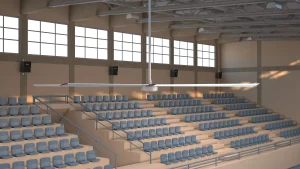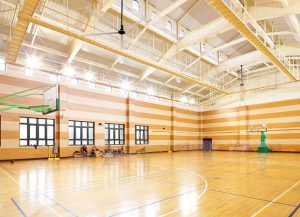Many people struggle with stuffy or inconsistent indoor air, which affects comfort and productivity. The problem worsens in busy factories or crowded commercial spaces. Fortunately, there’s an efficient solution: installing the best ceiling fan. Let’s explore how to overcome these temperature woes for healthier, happier environments.
The best ceiling fan for your space balances fan size, ceiling height, and fan blade design. Assess the room’s dimensions and airflow needs to choose the right ceiling fan style that delivers energy efficiency, quiet performance, and desirable aesthetics. Finally, confirm the fan motor meets high-quality standards for longevity.

ceiling fan example
Selecting the right ceiling fan can sometimes feel overwhelming if you’re looking for a fan that provides both style and comfort. Many ceiling fans are designed for use in various spaces, ranging from homes to industrial settings like factories or commercial buildings.
When you choose the right ceiling fan, consider factors such as ceiling height, room dimensions, and fan speed requirements. For instance, a robust industrial fan might be necessary for large warehouses, while small ceiling fans could suffice in cozier rooms. The number of fan blades and fan motor construction also matter. An advanced motor ensures quieter operation and more efficient airflow, giving you better temperature control without hefty energy bills.
Our Identity: As an HVLS fans manufacturing plant, we specialize in large, high-volume, low-speed ceiling fans that excel in effective air circulation, temperature management, and energy cost savings. We aim to guide you in making the best choice for your unique environment—whether it’s a sports center or a manufacturing facility.
Ceiling fan style plays a crucial role in the ambiance of your room. Modern ceiling fans or farmhouse ceiling fans can drastically shape your interior’s look and feel. If you prefer a sleek aesthetic, a modern ceiling design complements offices, showrooms, or lobbies. In contrast, a traditional ceiling fan may resonate well with classic décor and more rustic themes.
From my experience, the style ceiling you go for should mirror your company’s image or personal taste. Fan finishes such as brushed nickel, matte black, or white ceiling fans can further personalize the space. Additionally, ceiling fans without lights offer a minimalistic approach, while a ceiling fan with lights adds a functional glow. Whether you pick a ceiling fan with a pull chain or a remote-controlled model, always check that it matches both practical needs and visual appeal.
Ceiling fans come in a variety of shapes, sizes, and power capacities. One fan may be sufficient for small offices, while multiple fans are ideal for expansive factory floors or gyms. If you’re looking for a fan that caters to large commercial buildings, fans often feature durable metals and corrosion-resistant finishes.
Because fans come in a variety of blade lengths, angles, and speeds, you should assess your environment’s average temperature, humidity, and occupant density. For instance, ceiling fans are ideal for moderate climates but can also assist in more extreme conditions when used alongside heating, ventilation, and air conditioning (HVAC) systems. This synergy can minimize energy costs significantly, a must for organizations focusing on sustainable solutions.
When shopping for a new ceiling fixture, always rely on a ceiling fan size guide to determine the appropriate ceiling fan size. Fan size directly impacts how effectively the fan can move air. A ceiling fan size misaligned with your room dimensions may cause underwhelming or excessive airflow.
Remember, the number of fan blades also affects performance. Typically, a balanced blade count enhances both airflow and aesthetic. Modern ceiling fans often push more cubic feet per minute (CFM) of air, providing better ventilation and consistent circulation.
Whether you prefer an outdoor ceiling fan or an indoor ceiling model, the environment determines design materials and additional features. Outdoor ceiling fan constructions use moisture-resistant components to handle humidity or rain, making them suitable for open-air gymnasiums or partially sheltered warehouses. Meanwhile, an indoor ceiling fan is perfect for climate-controlled interiors.
When considering a ceiling fan for an outdoor space, it’s essential to check its UL rating. Damp-rated fans can endure covered patios or breezeways, while wet-rated fans survive direct rain exposure. By choosing the right size fan for exterior areas, you ensure comfortable gatherings and efficient energy usage all year round.
The fan blade count and blade pitch significantly influence airflow. Blade fans with fewer blades typically spin faster and can generate strong breezes. In contrast, more blades may bring quieter operation at slightly lower speeds. Fans often come with four to six blades in standard consumer models, while some industrial variants can have more.
Equally vital is the fan motor. A high-quality motor ensures smoother performance, prolonged durability, and reduced noise. Whether you lean toward a DC or AC motor, always consider overall efficiency and lifespan. A well-made ceiling fan motor is especially critical in massive commercial structures where the fan must run for extended hours each day without faltering.
Proper ceiling fan installation ensures safe and optimal performance. If your ceiling is sloped, you may need a special mounting bracket or a ceiling fan downrod to maintain correct clearance. Fans are mounted at the recommended ceiling fan height—generally 7-9 feet from the floor—to maximize comfort and safety.
Here’s a quick installation checklist:
In industrial spaces, ceiling fans can help stabilize indoor temperatures while lowering heating and cooling expenses. Our HVLS fans, specifically, are robust solutions that can mount high on the ceiling yet still deliver massive airflow. For additional insights, you can refer to our industrial HVLS fans page.
Smart ceiling fans integrate seamlessly with home automation systems, enabling smartphone or voice control. These advanced ceiling fan features may include temperature sensors, speed adjustments, or scheduling. For instance, running your fan automatically at cooler times of the day conserves energy without compromising comfort.
In searching for the best ceiling fan, people often look for reversible motors that switch direction between summer and winter modes. This functionality pushes warm air downward during colder months and pulls cool air upward when it’s hot. By pairing these features with your building’s current climate control, you maximize comfort and slash operating costs.
Correctly mount ceiling fans to achieve top performance. A standard or flush mount might suffice for smaller spaces, while extended rods are best for high ceilings. If you fail to mount ceiling fan units at the right height, airflow might be poor, and occupant comfort can suffer.
Ceiling fan height guidelines usually suggest at least 7 feet from the floor, with a minimum distance of 8 inches from the ceiling itself. This ensures the fan can move air efficiently. If you notice any wobbling or reduced airflow after installation, it’s wise to review your mounting hardware and balancing weights.
A traditional ceiling fan typically features a pull chain, a standard lighting kit, and conventional blade designs. Though they might look classic, they can still pack advanced technology in the fan motor for quieter performance. Some traditional ceiling fan models also come in decorative finishes that add nostalgic charm to your environment.
Meanwhile, modern ceiling fans put emphasis on streamlined shapes, energy-efficient motors, and often, remote or app-based controls. They deliver a sleek, contemporary vibe that aligns with offices, commercial showrooms, or modern warehouses. If you want an extremely robust solution, large HVLS fans can outperform any small fixture by circulating huge volumes of air in big industrial or sports facilities.
Below are further details to help you choose the right size fan and features for your situation:

HVLS Fans in Large Space
How do I determine the correct ceiling fan size for my space?
Start by measuring the room’s dimensions and referencing a ceiling fan size guide. Larger rooms typically need large ceiling fans (over 56 inches), while smaller rooms can use more compact fans. For instance, a 400-square-foot space may need a fan 56 inches or larger.
What if the fan includes a light kit and I already have another fixture?
You can pair a fan with a pull chain and a separate lighting system if desired. A fan includes a light kit is optional in many models, allowing you to install or remove the light function based on your preference. Check compatibility and wiring guides before making changes.
Which types of ceiling fans work best for industrial environments?
An industrial fan or large HVLS fan is often the most effective in manufacturing plants, warehouses, and expansive commercial facilities. These fans often feature advanced motors, sturdy materials, and optimal blade designs.
Can I install a smart ceiling system if I have an older setup?
Yes. Smart ceiling fans typically only require a compatible motor and control module. Many ceiling fan models have upgrade kits for remote or app-based control. Updating an existing fan might involve adding a receiver and using a Wi-Fi or Bluetooth-enabled device.
Should I get a ceiling fan for your space with or without lights?
Ceiling fans without lights streamline aesthetics and can reduce energy usage slightly. However, a fan with a light is helpful in areas lacking sufficient overhead illumination. If you need multi-functional lighting, a ceiling fan with a pull chain can toggle both the fan and light.
Is it better to have more blades on a fan?
The number of fan blades can affect airflow and noise. Fewer blades can generate stronger breezes but might be slightly louder. More blades reduce noise but may move air at a different rate. For large areas, HVLS fans—some with 6 or more blades—excel in distributing air quietly and efficiently.
Table: Fan Size vs. Recommended Room Area
| Fan Size | Room Area (sq. ft.) | Example Use Case |
|---|---|---|
| 29–36 inches | Up to 75 | Small office, break room |
| 37–48 inches | 76–175 | Mid-sized office, meeting room |
| 49–56 inches | 176–400 | Larger office, retail store |
| 57+ inches | 400+ | Factory, warehouse, sports center |

HVLS Fan in a Factory
We are a dedicated HVLS fans manufacturing operation committed to creating high-quality large fans that cater to factories, commercial buildings, sports centers, gyms, schools, warehouses, and manufacturing facilities. Our fans offer superior airflow, bringing down energy costs by efficiently circulating air in areas where a standard new fan might not suffice.
By choosing our HVLS solutions, you:
If you’re looking for a robust solution, check our HVLS fans for large spaces and discover how our advanced technologies can transform your facility.
Check out our ceiling fan maintenance tips and reach out for installation assistance or queries about upgrades. We’re here to help you confidently choose a ceiling fan and elevate your environment’s comfort.

Hi, I’m Michael Danielsson, CEO of Vindus Fans, with over 15 years of experience in the engineering and design industry. I’m here to share what I’ve learned. If you have any questions, feel free to contact me at any time. Let’s grow together!